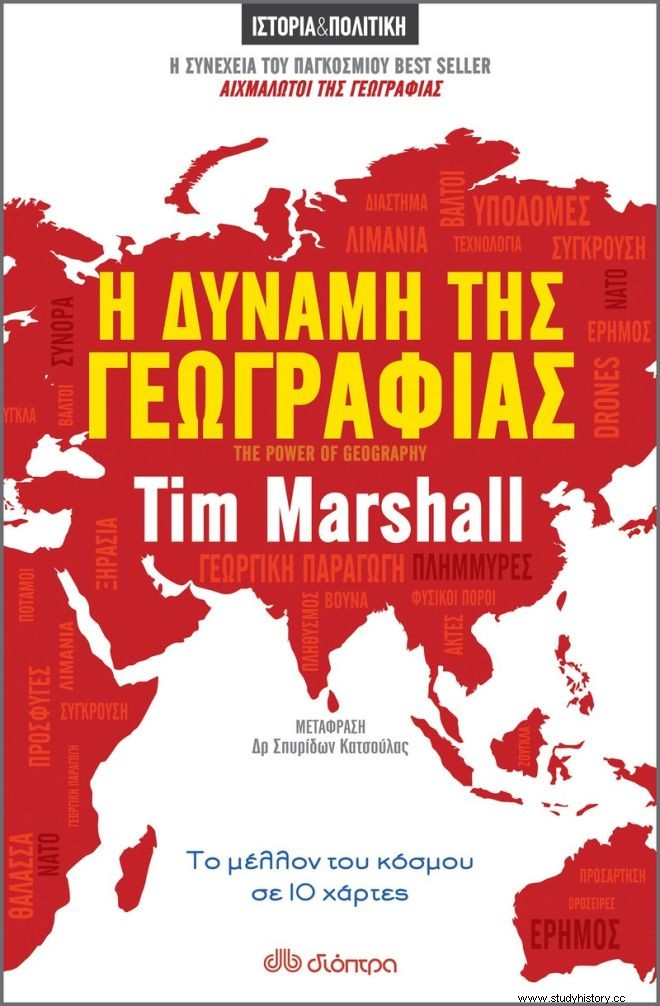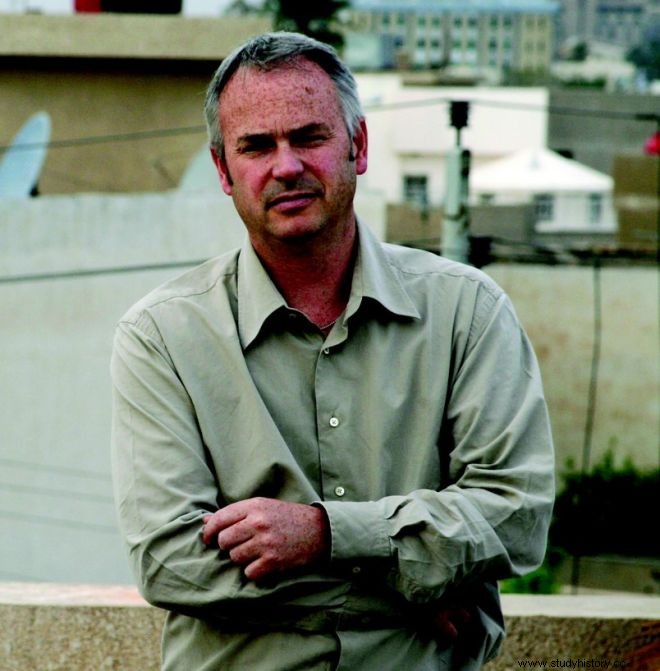Captives of Geography, Raising Walls, For a Flag. Tim Marshall has already been loved by the Greek public with his inventive and popularized historical recording, and now he comes to give us one more of his work, which is again published by Dioptra publications.
In his new book, "The Power of Geography" which "comes" on October 6, Marshall takes us on a journey through 10 regions that have forever determined the global political scene, and the balance of power. In this work, the reader can understand why the Earth's atmosphere is the next battlefield, why the battle for the Pacific begins now, and why Europe's next migration crisis is much closer than we think.
In ten chapters, covering Australia, the Sahel, Greece, Turkey, the United Kingdom, Iran, Ethiopia, Saudi Arabia, Spain and Space, delivered with Marshall's characteristic acuity and insight, he offers the reader an enlightening and fascinating exploration of the power of geography in shaping humanity's past, present and future. Once again, journalist Tim Marshall writes here with his intense and experiential perspective, which is not reminiscent of "classic", geopolitical analyses.
In the extensive chapter on our country, the role of Greece's geophysical position in shaping its history, at the "crossroads" of the Middle East, North Africa and of course Europe, is examined, as well as why the Greeks "turned" to the sea, conquering the waterways.

Below, you can read an exclusive pre-publication of the book as provided by Dioptra Publications for NEWS 24/7.
CHAPTER 6
TURKEY
"We look alike to ourselves".
Mustafa Kemal Ataturk
[…]
From about the ninth century, nomadic Turkic tribes had begun to emerge from the Eastern Steppe (Mongolia), pass through the Altai Mountains, cross the Western Steppe (Kazakhstan), turn left into the Central Asia and reach the Caspian Sea just in time to meet the Byzantine Empire. By then they had already come into contact with Islam in the area around Persia and had converted to it, abandoning their pagan beliefs. They appeared on the fringes of the empire in the eleventh century and began raiding Anatolia. In 1037, the Turkish Seljuk Empire was formed in the area where Armenia is today, on the borders of Byzantine territory. Then the sultan set his sights on Georgia, something that the Byzantine emperor Romanos IV Diogenes could not tolerate. Something had to be done.
In 1071 the Byzantine army faced the Seljuks at Manzikert, near Lake Van, about 120 kilometers from the present-day Turkish-Iranian border. He was utterly defeated, leaving the gate wide open for the various Turkic clans to overrun Anatolia and establish a mosaic of emirates. Within a decade they had approached Constantinople and named their new territory the "Sultanate of Rum", which one might take as an early form of trolling, considering that this was the name they used for Rome.
At that time the inhabitants of Anatolia spoke mainly Indo-European languages and from the time of the conquests of Alexander the Great they had adopted the Greek traditions, among which, during the Byzantine period, the Christian religion. It consisted of a panspermia of ethnicities, including Armenians, Kurds and Greeks. With the passage of several centuries, many of them were assimilated by the Turkish culture, some embraced Sunni Islam and adopted the Turkish language, while at the same time the Turks were genetically integrating with the people of Anatolia. Most modern Turks are more closely related to Armenians and Greeks than to Turkic races such as the Kazakhs, while studies show that 9% to 15% of their genetic admixture comes from Central Asia.
One of the many emirates established in northwestern Anatolia at the end of the thirteenth century was that of Osman Ghazi (Osman the Warrior). He managed to expand his territory by conquering Byzantine lands along the Black Sea coast and penetrating central Anatolia. In honor of their founder, the citizens began to call themselves Osmanli, which means "followers of Osman" and which in Western Europe turned into Ottomans. They were by no means the greatest of the Turkish powers, but they used their gains as a springboard to wrest more territory from the Byzantines and the other Turkish emirates.
By 1326 the emirate had taken control of Bursa, nearly 150 kilometers south of Constantinople, which now also outshined them. The Ottomans were slowly gnawing away at the surrounding lands and by 1453 the emblematic city of what was left of the Byzantine empire found itself isolated. Its imposing walls had endured for a thousand years, but for fifty-three days the Ottoman army pounded them mercilessly, eventually causing openings through which its warriors rushed in.
Now they had to either get rich or die trying. It was necessary to ensure that no other strong regional power would emerge capable of raiding the Anatolian highlands and that they could block any significant force coming from the Middle East.
The weakest point of this excellent location is where the plain dips in front of the isthmus where Constantinople dominates. If you can muster enough ground troops and advance from there to the city, then the very core of the country is at risk. The key, therefore, to the defense of the city is first of all to have a reliable navy able to block the narrow sea passages, and then to keep the enemy ground troops as far away from the core as possible. To do this you need to expand the core.
"Marmaria" therefore had to be shielded and then spread, so the Turks had first and foremost to secure the route they had followed to conquer the prize. They had occupied large parts of Anatolia, but, apart from strategic depth, they offered them nothing more. These are mainly dry, rough and mountainous lands, with limited possibilities for agricultural exploitation. Much of the southern Anatolian coastline is flat and has some good harbors for trade as well as, thanks to some narrow coastal plains, some room for cultivation. The colonization and development of the interior therefore did not particularly concern the Ottomans. There were, of course, the various power bases to deal with where disturbances were often caused, but all they had to do was suppress them. Throughout most of its history, the Ottoman Empire struggled to contain rebellions in Anatolia, a problem that modern Turkey has inherited in the form of Kurdish rebellions.
However, priority was given to the use of Anatolia for defense. With the area under control, it pretty much closed the back door to a major invasion, and there were now few challengers willing to cross the plateau to get to them anyway. In the northwest, they had extended to the Balkan mountain range, which offered them a physical barrier against threats from that direction. Now they could shield Constantinople as the capital of their empire – the walls were rebuilt and the urban areas populated with thousands of Muslims, Christians and Jews – and then start looking beyond the horizon...
(The continuation in the book)

Author's Who is Who
Tim Marshall is Sky News' Diplomatic Editor. Considered an authority on international relations, he has been a war correspondent in thirty countries, reporting on the wars in Croatia, Bosnia, North Macedonia, Kosovo, Afghanistan, Iraq, Lebanon and Israel, and has covered three US presidential elections. The Foreign Matters blog was among the candidates for the Orwell Prize in 2010.
In 2004, Marshall was among the finalists in the RTS News Event category for his coverage of the war in Iraq, as well as in the New York Film Festival for his documentary The Kingdom of the Desert and in 2007 for his report on the Mujahideen.
Tim Marshall is the author of Prisoners of Geography, a perennial bestseller, which together with Raising Walls and For a Flag form a trilogy on geopolitics and diplomacy. The book Prisoners of Geography is also published in an illustrated version for children by Dioptra publications.
The translation of the publication has been done by Dr. International Relations and Strategy, Spyros Katsoulas. Dr. Spyros Katsoulas is an internationalist specializing in geopolitics and strategic history. He graduated from Panteion University and then completed his postgraduate and doctoral studies in England. He is a scientific associate of IDIS, a lecturer at SETHA and editor-in-chief of Strategein magazine. It is also active in the translation of books of international interest into Greek.
Follow News247.gr on Google News and be the first to know all the news
